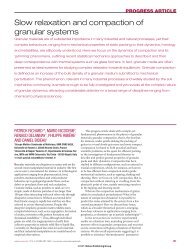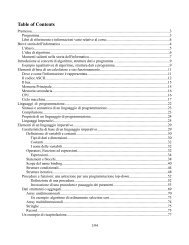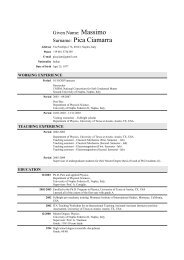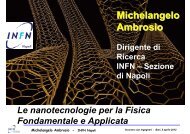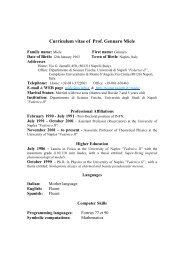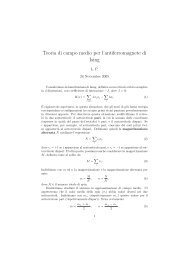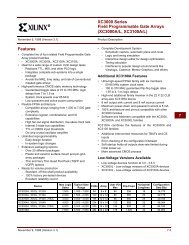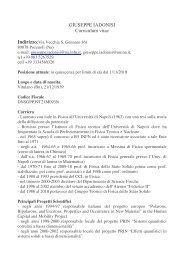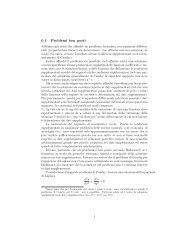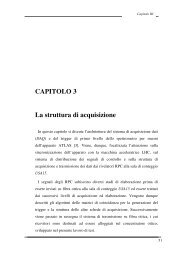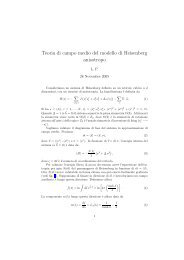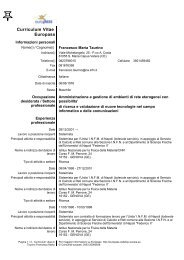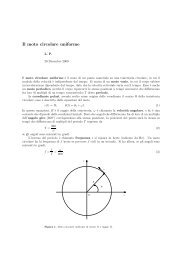Phys Rev E
Phys Rev E
Phys Rev E
You also want an ePaper? Increase the reach of your titles
YUMPU automatically turns print PDFs into web optimized ePapers that Google loves.
MANZO et al. PHYSICAL REVIEW E 73, 051707 2006<br />
0 = a7 − a6. 17<br />
In concluding this section, we note that the theory we have<br />
just described and in particular the constitutive equations we<br />
have adopted for the photoinduced torque density and stress<br />
tensor already imply that the photoinduced angular momentum<br />
transfer associated with the dye is fully internal to the<br />
liquid crystal. Indeed, the flux of angular momentum through<br />
any boundary surface, as given by Eq. 15, will vanish identically<br />
if the stress tensor vanishes on it. Since we have assumed<br />
that all material constants ai are proportional to the<br />
dye concentration, they should vanish on a surface lying just<br />
outside the liquid crystal in water and therefore the flux of<br />
angular momentum through such a surface will vanish, i.e.,<br />
one has Mph =0. We note that the same argument does not<br />
hold for Mem ,astem has a finite value also in the isotropic<br />
liquid.<br />
Is there a possible way out of this conclusion, justifying<br />
perhaps a hypothetical photoinduced flow of angular momentum<br />
out of the liquid crystal? Within a first-order theory<br />
of the constitutive equations the answer is no. However, it<br />
cannot be a priori excluded that higher-order terms in the<br />
constitutive equations become important in specific situations<br />
and justify a strong exchange of angular momentum<br />
with the outside. For example, at the surfaces between the<br />
liquid crystal and the surrounding medium, the mass and<br />
composition densities suffer sharp discontinuities. Therefore<br />
a first-order theory in the spatial gradients is clearly not justified<br />
anymore this, by the way, is just how surface anchoring<br />
enters the problem. It would then be conceivable that<br />
higher-order terms in the photoinduced torque density and<br />
stress-tensor expressions could give rise to photoinduced surface<br />
effects leading to a significant angular momentum exchange<br />
with the outside, i.e., to a Mph0. In the end, this<br />
hypothesis can only be tested, and eventually ruled out, experimentally.<br />
III. DROPLET ROTATIONAL DYNAMICS<br />
Equations 1–3, supplemented with all constitutive<br />
equations for torque densities and stress tensors, completely<br />
define the light-induced dynamics of the liquid crystal. In the<br />
case of a droplet of liquid crystal immersed in water one<br />
should also include in the system the appropriate boundary<br />
conditions at the droplet surface. We limit ourselves to mentioning<br />
them: continuity of fluid velocity and forces across<br />
the boundary, continuity of tangential components of E and<br />
of normal components of D, continuity of B, and appropriate<br />
anchoring conditions on n. Moreover, one should account for<br />
the dynamics of the water surrounding the droplet. The latter<br />
is also governed by Eq. 2, but with a simpler expression of<br />
the stress tensor, including only hydrostatic pressure, Newtonian<br />
viscosity, and the electromagnetic stress tensor.<br />
The resulting system of equations is clearly very complex<br />
and an exact solution can be determined only numerically. In<br />
the following, we instead approach the problem analytically<br />
with the help of several approximations.<br />
First, we will assume that the droplet is always perfectly<br />
spherical, with a radius R and a total mass m spherical<br />
051707-4<br />
droplet approximation SDA. This is an approximation because<br />
anchoring effects combined with elastic interactions<br />
may actually slightly distort the shape of the droplet into an<br />
ellipsoid. The molecular director configuration within the<br />
droplet will be taken to be axial, namely the director n has a<br />
well-defined uniform direction close to the center of the<br />
droplet, while it will be distorted to some extent close to the<br />
surface due to anchoring 20,21,24. This allows one to properly<br />
define an average molecular director of the droplet.<br />
Second, for calculating exactly the overall electromagnetic<br />
torque acting on the droplet we would have to determine<br />
in all details the light propagation within the spherical<br />
droplet, including all the birefringence and wave diffraction<br />
Mie scattering effects: an exceedingly complex task. Instead,<br />
following a common practice in the literature 22–24,<br />
we will use an approximate expression of the electromagnetic<br />
torque obtained by simply replacing the spherical droplet<br />
with a homogeneous slab of liquid crystal having a thickness<br />
equal to the droplet diameter and the strongly focused<br />
light beam with a plane wave planar symmetry approximation<br />
PSA. This approximation will tend to become more<br />
exact in the limit of large droplets and weakly focused light<br />
beams.<br />
Third, we will restrict the possible dynamics of the fluid<br />
and the director to either one of the following two approximate<br />
models: i the droplet behaves exactly as a rigid body,<br />
i.e., rotating only as a whole and with the director perfectly<br />
locked to the fluid rigid body approximation RBA; or<br />
ii the droplet fluid flow and director are allowed to have<br />
different, although uniform, rotation dynamics but the director<br />
field is taken to be perfectly uniform uniform director<br />
approximation UDA.<br />
Let us now go into the details of the outlined approximations.<br />
The SDA approximation needs no further comments,<br />
so we move on to the calculation of the total electromagnetic<br />
torque acting on the droplet within the PSA approximation.<br />
A. Total external electromagnetic torque<br />
We assume that a focused light beam passes through a<br />
liquid crystal droplet and that the average molecular director<br />
inside the droplet is oriented perpendicular to the beam axis.<br />
We choose a reference system in which the z axis coincides<br />
with the beam axis and the average molecular director lies in<br />
the xy plane. Note that, even if initially the average director<br />
of the droplet will not necessarily lie in the xy plane, the<br />
electromagnetic torque itself will force it there, in order to<br />
align the director to the optical electric field. So, at steady<br />
state, our assumption will be always verified.<br />
In order to calculate the total electromagnetic torque we<br />
must use either Eq. 14 or Eq. 15, with =em and with<br />
expressions 7 and 8 of the torque density and stress tensor,<br />
respectively. The main difficulty is that the field to be<br />
used in the integrals is the total one, including both the external<br />
input field and the diffracted or scattered one. Neglecting<br />
the latter will give a vanishing result. So we need to<br />
calculate the propagation of light in the birefringent droplet.<br />
The first approximation introduced here for this calculation<br />
consists of simply replacing the droplet with a uniform pla-



